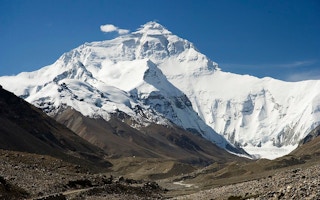Scientists have set a new record for the identification of microplastic fibres − an altitude record. They have found them at 8,440 metres high in the Himalayas, almost at the summit of Mt Everest.
It should be no surprise. Microplastic fibres and polymer fragments − derived from plastic products and especially from plastic waste − have been found in the sediments at the bottom of the sea, on the beaches around barren Antarctic islands, in the Arctic ice, on the surfaces of the ocean, and in the tissues of living things, from sea snails to whales.
And as the issue of plastic pollution made its way up the political agenda, it has now also climbed Mt Everest. Researchers report, in the journal One Earth, that they identified 12 fibrous plastic particles in every litre of snow from the highest measuring point, the so-called Balcony of Everest; particles were also identified in stream water at high altitudes and in even greater numbers − 79 per litre of snow − at the famous Everest Base Camp.
Their arrival on the world’s highest and most famous peak would have been inevitable. Seventy years ago manufacturers made plastic products at the rate of 5 million tonnes a year. In 2020, the world purchased 330 million tonnes, much of it used once and discarded.
“
It really surprised me to find microplastics in every single snow sample I analysed. Mt Everest is somewhere I had always considered remote and pristine.
Imogen Napper, marine scientist, University of Plymouth
Somewhere between 93,000 tonnes and 236,000 tonnes is estimated to be floating on the sea surfaces. The cascade of polyester, acrylic, nylon, polypropylene and other polymer waste could increase threefold in the next two decades.
And just as there is more plastic on the planet, so there are more and more visitors to Sagamartha National Park in Nepal, and to the slopes of Mt Everest. In 1979, the region was host to 3,600 trekkers and climbers. By 2016, that number had climbed to 45,000. By 2019, climbers were forming an orderly queue and taking turns to reach the summit.
And each of these would have been wearing high-performance outdoor clothing, while carrying − and sometimes leaving behind − ropes, tents and lunch boxes fashioned from polymer materials.
The snow samples were collected by a National Geographic research team
formed to investigate the impact of climate change on the world’s highest peak, and studied by Imogen Napper of the University of Plymouth in the UK.
No longer pristine
“Mt Everest has been described as the world’s highest junkyard. Microplastics haven’t been studied on the mountain before, but they are generally just as persistent and typically more difficult to remove than larger items of debris,” Dr Napper said.
“I didn’t know what to expect in terms of results, but it really surprised me to find microplastics in every single snow sample I analysed. Mt Everest is somewhere I had always considered remote and pristine. To know we are polluting near the top of the tallest mountain is a real eye-opener.”
She added: “These are the highest microplastics discovered so far. While it sounds exciting, it means that microplastics have been discovered from the depths of the ocean all the way to the highest mountain on Earth.
“With microplastics so ubiquitous in our environment, it’s time to focus on informing appropriate environmental solutions. We need to protect and care for our planet.”
This story was published with permission from Climate News Network.










